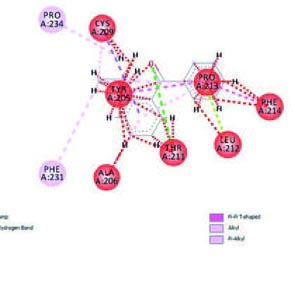 Smart Citations
Smart CitationsSee how this article has been cited at scite.ai
scite shows how a scientific paper has been cited by providing the context of the citation, a classification describing whether it supports, mentions, or contrasts the cited claim, and a label indicating in which section the citation was made.
Molecular docking analysis of seagrass (Enhalus acoroides) phytochemical compounds as an antidiabetic
Enhalus acoroides have potential to inhibit the α-glucosidase enzyme and as an antidiabetic drug. Twenty-seven phytochemical compounds of seagrass (E. acoroides) were analyzed by molecular docking method. All possible candidate compounds predicted ADME pharmacokinetic properties using the swiss ADME website. A molecular docking analysis was carried out using the PyRx 0.8 Autodock Vina software. Furthermore, the interaction analysis between molecules was carried out using PyMOL software and the Discovery Studio Visualizer BIOVIA. There were 17 of the 27 compounds which had the best potency as oral antidiabetic drug candidates. The validation results showed that all ligands had aroot mean score deviation (RMSD) value <2Å with the best value of 0.0. The binding affinity with the strongest bond value was -9.2 (kcal/mol) on the NAMPT bond with tannin, while the weakest value was 40.01 at 3l4y (α-glucosidase) with 3-methyl. The 2h6d receptor can bind to all ligands, and the α-glucosidase receptor can bind to two test ligands. The docking method used in this study was valid, and the phytochemical compounds of seagrass have the potential to be an alternative to antidiabetic drugs.
Downloads
How to Cite
PAGEPress has chosen to apply the Creative Commons Attribution NonCommercial 4.0 International License (CC BY-NC 4.0) to all manuscripts to be published.

 https://doi.org/10.4081/jbr.2022.10224
https://doi.org/10.4081/jbr.2022.10224





